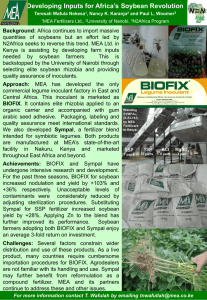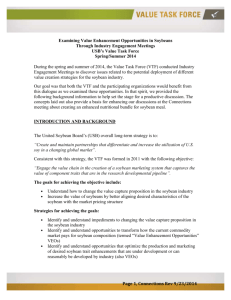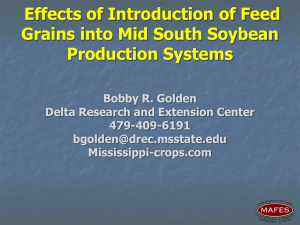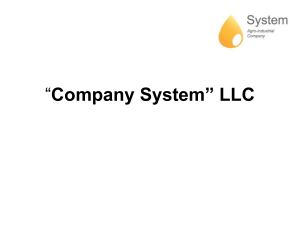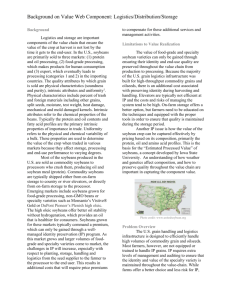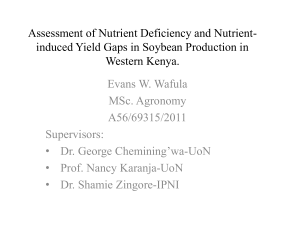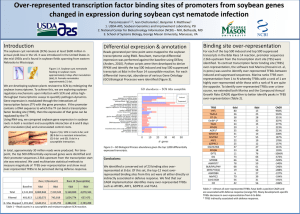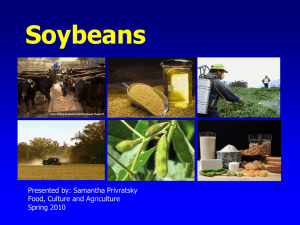Soybeans: An Alternative Energy Source
advertisement
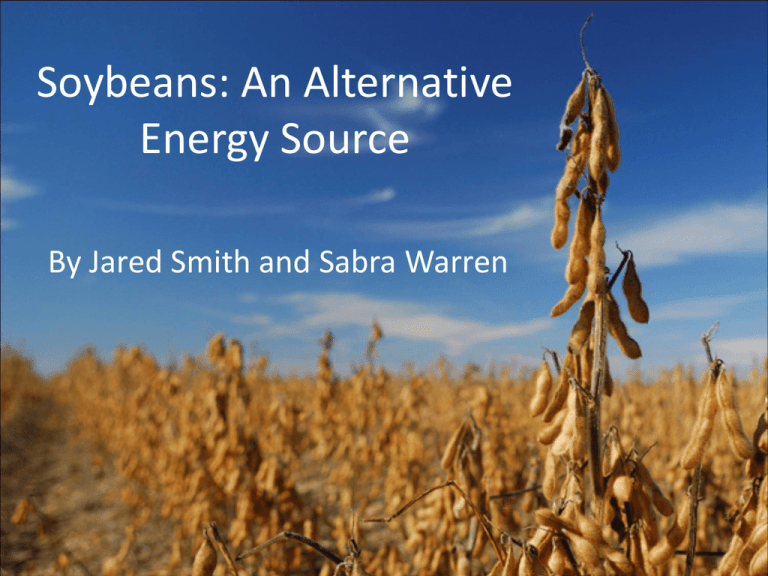
Soybeans: An Alternative Energy Source By Jared Smith and Sabra Warren • • • • Overview Purpose Soybean Usage Soybean Biofuel Information Growth Conditions – Water Requirements – Soil Conditions • Potential New York State Soybean Growing Locations • Potential Biofuel Production Purpose • To determine suitable locations for growing soybeans in NY • Soybeans will be used for the production of biofuel • Used Arc Map for analysis of possible growing locations and potential yield Current Uses of Soybeans • World’s most widely used editable oil • According to USDA Economic Research Service, soybean oil represents 71.3% of U.S. fats and oils consumption Feed & Animal Food (77%) Salad / Cooling Oil (11%) Baking / Frying Fats (6%) Biodiesel (3%) Margarine (1%) Human Food Protein (1%) Other (1%) Source (5,4) Soy as Biodiesel • Biofuel - non-petroleum based alternative fuels • Plants: Corn, Soy, Hemp, Switch Grass • One bushel of soybeans produces about 1.5 gallons of biodiesel • Produced in simple refining process - trans esterification. • • • Mix methanol with sodium hydroxide into solution Mixing solution with soybean oil Final products: Methyl Esters (Biodiesel) and glycerin • Positive energy balance of 3:1 • • • Ester-based feedstock Low-energy requirements of conversion process Nitrogen-fixing characteristics of soybeans • Returns 93 percent more energy than is used to produce it • Source (2) Corn grain ethanol provides only 25 percent more energy Benefits of Soybeans as Biofuel • Soybean biodiesel uses only soybean oil • 80% of the plant remains for animal and human consumption • Only 3% of domestically consumed soybean crop needed for biofuel • Ethanol requires ~20%) • Eliminates emission of sulfur oxides and sulfates: components of acid rain • Reduces CO2 emissions by up to 78% • Biodiesel is biodegradable and nontoxic when used in its pure form (B100) Source (3) http://www.our-energy.com/biofuels.html Growing Requirements • Water: • Yields between 40 to 50 bushels/acre • Requires 20 to 25 inches of soil moisture (rainfall) • Produces approximately 2 bushels/acre for every inch of water used • Soil: • • • • • • • Source (1,6) Fertile and well drained pH of 6.5 or higher No sand or gravel Best results on: sandy silt loams silt loams clay silt loams General Soybean Growth and Water Use Crop Development Water Use (in/day) Germination and seeding 0.05 - 0.10 Rapid vegetative growth 0.10 - 0.20 Flowering to pod fill 0.20 - 0.30 Maturity to harvest 0.05 - 0.20 • Water requirements vary depending on development period • The length of the total growing period is 100 to 130 days or more http://www.fao.org/docrep/S2022E/s2022e02.htm Source (6) Select Locations • map Potential Biodiesel Output From Select Locations • • • • • 21,577,849 acres of suitable land 766,376 acres of current soybean crops Average rainfall: 34.8 inches Potentially 69.6 bushels per acre yield Yield dependent on other growing conditions, and amount of land planted • Potentially 1,448,478,521 bushels total yield • Would produce 2,172,717,781 gallons of biofuel per growing season Environmental Benefits • New York Oil Consumption: • 12.9 Trillion gallons per year • Soybeans provide 2.17 Trillion gallons per year • OR 16.8% of New York’s Annual Oil Consumption • Carbon Dioxide Reduction: • 12.9 Trillion gallons = 172 Quadrillion kg CO2 • 2.17 Trillion gallons = 28.9 Quadrillion kg CO2 less • OR 16.8% less CO2 • Global Warming Implications: • 172 Quadrillion kg CO2 = 0.005 °C • 28.9 Quadrillion kg CO2 less = 0.0009 °C less • OR 16.8% less temperature increase • Soybean production to biofuels is a profitable resource with environmentally friendly benefits • NY State has the potential to grow and produce soybean biofuel to significantly offset fossil fuel demand • The use of Arc Map enhances the ability for such analysis to be done Conclusion Thank You! Questions? Bibliography • Source (1) Cox, William J.. “Fact Sheet #1 in a Series on Soybeans.” Northern New York Agricultural Development Program. April 2004. 17 April 2011. <http://www.nnyagdev.org/PDF/NNYSoybeansFS.pdf>. • Source (2) Inside Indiana Business. “Soybean Processing, Biofuels Plant Opens in Northern Indiana.” Claypool. 2007. 17 April 2011. < http://www.insideindianabusiness.com/newsitem.asp?id=25053>. • Source (3) Iowa State University. “Soybean Uses.” Soybean Extension of Research Program. 2011. 17 April 2011. < http://extension.agron.iastate.edu/soybean/uses_biodiesel.html>. • Source (4) Soy Connection. “Soybean Oil Overview.” Soybean Oil. 2011. 17 April, 2011. <http://www.soyconnection.com/soybean_oil/soybean_oil_overview.php>. • Source (5) United Soybean Board. “Food and Fuel: Meeting the Challenges of Feeding the World and Creating Renewable Fuels.” Food Versus Fuel: The Debate. 2009. 17 April, 2011. <http://www.soyconnection.com/soybean_oil/pdf/foodvsfuel_soy_biofuels.pdf>. • Source (6) University of Arkansas Division of Agriculture. “Soil and Water Management Soybeans – Crop Irrigation.” Cooperative Extension Service. 2006. 17 April 2011. <http://www.aragriculture.org/soil_water/irrigation/crop/soybeans.htm>. • Source (7) University of Minnesota. “Soybean biodiesel has higher net energy benefit than corn ethanol.” Mongabay. July 11, 2006. 17 April 2011. <http://news.mongabay.com/2006/0711-umn.html>.

